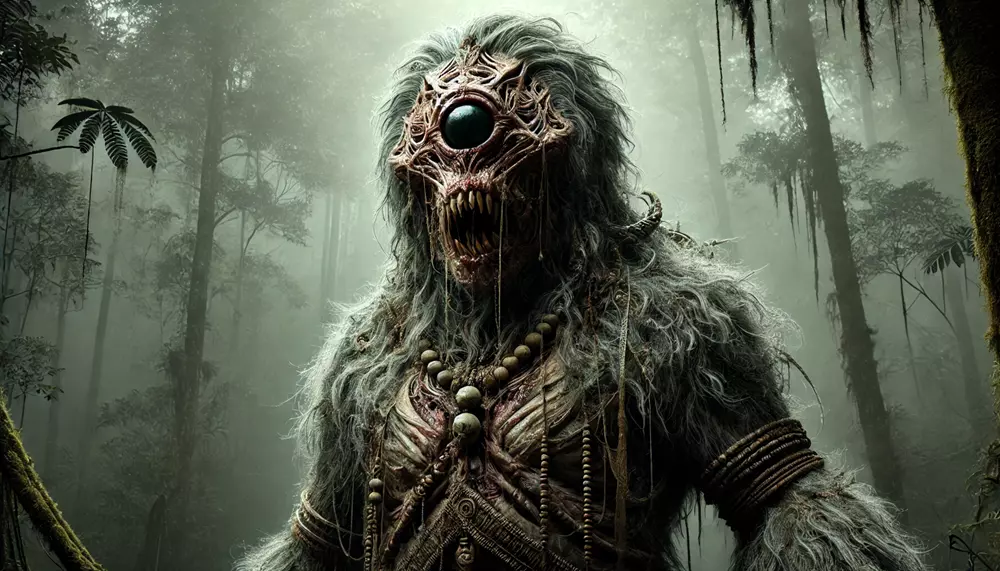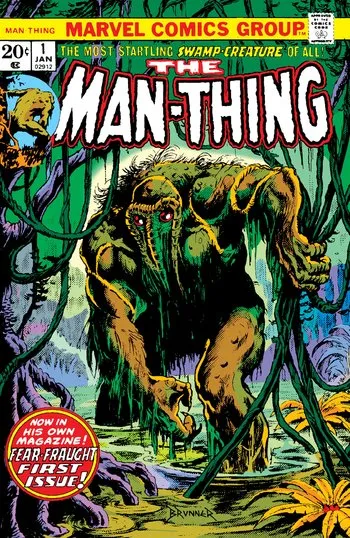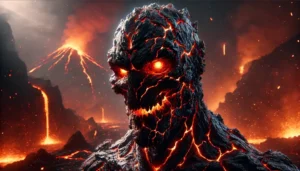Intro/Summary
The Mapinguari is a legendary creature from South American folklore, especially rooted in the Amazonian rainforest. Known for its giant, humanoid appearance with a gaping mouth on its belly, it’s a terrifying symbol of nature’s raw power. This cryptid, believed to guard the forest, embodies both mythical terror and ecological symbolism. Its myths serve as a warning about respecting the untamed wilderness, blending ancient Amazonian spirituality with vivid storytelling.
“Many believe the Mapinguari is more than a myth; it’s a reminder of humanity’s fragile place in nature’s grand design.”
History/Origin
The Mapinguari’s roots stretch deep into the myths of Indigenous Amazonian tribes. The oral traditions of groups like the Yanomami and Tupi people tell tales of a fearsome forest guardian that punishes those who disrespect the rainforest. While these stories vary, most depict the Mapinguari as a protector rather than a senseless monster.

Some legends suggest the Mapinguari was once a shaman who defied sacred laws, cursed into a grotesque form as punishment. In this narrative, the creature serves as a cautionary figure, deterring greed and exploitation. Similar to many South American mythologies, it bridges the gap between human and divine realms.
Anthropologists have traced descriptions of the Mapinguari back to pre-Columbian civilizations. Scholars believe the creature’s traits may have been inspired by the megafauna of the Pleistocene era, such as the giant sloth, which once roamed the Amazon. A Tupi elder once remarked, “The Mapinguari is the soul of our ancestors’ warnings—do not destroy what gives us life.”
Name Meaning
The term “Mapinguari” comes from the Tupi-Guarani language, roughly translating to “roaring animal” or “fetid beast.” The name emphasizes its primal, wild essence, evoking fear and awe. It encapsulates the creature’s role as a force of nature, symbolizing untamed power and retribution.
Appearance
Descriptions of the Mapinguari vary, but it is most commonly depicted as a towering humanoid covered in matted fur. Its most horrifying feature is a vertical mouth located on its abdomen, often associated with consuming intruders. It’s also said to have one eye, long claws, and a rancid smell, a detail often linked to decay and death.
Some accounts compare its gait to that of a sloth, slow yet deliberate, adding an eerie quality. The creature’s physical form symbolizes the unnatural consequences of defying nature, a grotesque amalgamation of human, animal, and spirit.
Background Story
One common legend involves a greedy hunter who ventured deep into the forest, killing animals indiscriminately. The hunter encountered the Mapinguari, who unleashed its wrath to protect the forest’s sanctity. The creature’s roar was said to cause trees to tremble, and its claws shredded the hunter’s weapons like leaves.
This story reflects the Mapinguari’s dual role: a punisher of excess and a guardian of balance. Another tale recounts how the creature was once a wise shaman who attempted to gain eternal life. When his spell failed, the gods punished him, twisting his body into the horrifying Mapinguari as a warning against hubris.
Cultural Impact
The Mapinguari occupies a unique space in Amazonian folklore. Indigenous communities use its tales as ecological parables, teaching respect for the forest. Children are often warned that misbehaving or venturing too far from home may invoke the Mapinguari’s wrath.
Festivals in Brazil sometimes feature effigies of the Mapinguari, celebrating its mythical role as a forest guardian. For example, during the Festa da Floresta, locals dress in costumes resembling the creature, symbolizing their connection to the rainforest.
Its influence extends beyond oral storytelling. The Mapinguari has appeared in art, carvings, and even traditional dances. Its image serves as a reminder of humanity’s interconnectedness with nature and the need for sustainable practices.
Similar Beasts
The Mapinguari shares traits with several other mythical creatures worldwide. It is often compared to the Sasquatch or Bigfoot of North American folklore, as both are hairy, humanoid guardians of nature. The Wendigo from Native American legends similarly serves as a cautionary tale, representing greed and the consequences of disrespecting nature.
In South American mythology, the Mapinguari is akin to the “Yacuruna,” water spirits known for punishing those who harm their habitats. These parallels highlight universal themes of environmental stewardship and respect for natural laws.
Religion/Ritual
The Mapinguari plays a spiritual role in some Indigenous rituals. Tribes perform offerings to appease the forest spirits, including the Mapinguari, before hunting or gathering resources. These rituals often involve chants and symbolic gestures, emphasizing harmony with nature.
Shamans sometimes invoke the creature in storytelling ceremonies to teach lessons about greed and balance. Such practices ensure the myth remains alive and continues to guide future generations.
Scientific or Rational Explanations
Scientists have proposed that the Mapinguari myth may stem from encounters with prehistoric megafauna. The giant ground sloth, which existed until about 10,000 years ago, shares several physical traits with the Mapinguari, such as its size and fur.
Another explanation suggests the myth reflects psychological phenomena. The Amazon’s dense and mysterious environment can induce fear and hallucinations, leading to exaggerated accounts of encounters with wildlife. The rancid smell attributed to the Mapinguari might relate to decaying organic matter often found in tropical forests.
Modern Cultural References
The Mapinguari has emerged in various modern cultural forms, blending its folklore roots with contemporary media.
Literature
The Mapinguari: A Tale of Horror in the Amazon by Robert W. Morgan: This novel delves into the terrifying encounters with the Mapinguari, blending folklore with horror fiction.
Television
Destination Truth (Season 2, Episode 3): This paranormal reality series features an expedition into the Amazon rainforest to investigate sightings of the Mapinguari, exploring the creature’s myth and reported encounters.
Documentary
Mapinguari: Fearsome Beast and Protector of the Amazon: This documentary examines the legend of the Mapinguari, featuring interviews with locals and experts discussing its cultural significance and alleged sightings.

Video Games
AdventureQuest Worlds: The Mapinguari appears as a monster that players can encounter, reflecting its mythical attributes within the game’s universe.
Far Cry Primal: Players encounter creatures inspired by prehistoric fauna, resembling the Mapinguari’s traits of massive size and primal power
Music
Sepultura: The Brazilian metal band has referenced Amazonian myths, including the Mapinguari, in lyrics advocating for environmental conservation
Comics
Man-Thing by Marvel Comics: This character bears a resemblance to the Mapinguari in its role as a swamp-dwelling protector.
These instances highlight the Mapinguari’s presence in contemporary media, showcasing its transition from Amazonian folklore to modern entertainment platforms.
Conclusion
The Mapinguari stands as a powerful testament to the enduring legacy of Amazonian myths. Its story is a compelling blend of ecological warning and mystical intrigue, urging respect for the natural world. By bridging ancient tales with modern interpretations, the Mapinguari reminds us of the timeless dance between humanity and nature.
“Legends like the Mapinguari are more than stories; they are whispers from the past, urging us to tread lightly on this fragile Earth.”




